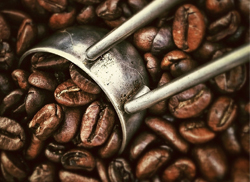
Kenya’s Colombia Mild is valued for its balance, and complex but powerful wine-toned acidity wrapped in sweet berry-toned fruitiness.
Kenya’s coffee industry is very popular, especially for its strong aroma, cooperative milling system and auctioneering. Kenya is rated 21st among the world’s best coffee producers. Coffee exports account for about five percent of all exports from Kenya.
About six million people are directly or indirectly employed by the coffee sector. Small-scale producers account for approximately 70 percent of coffee produced in Kenya.
Coffee was first grown in Kenya in 1893, primarily on large farms run by the British. By then auctions were held in London. In 1933, Kenya enacted the Coffee Act which established The Coffee Board of Kenya and later the Kenya Auction system. Mt Kenya region is the main coffee-growing area in Kenya. Other areas where coffee is grown include around Aberdare Ranges, Nyanza, Nakuru, Bungoma and Kisii. Kenyan coffee is dubbed the ‘Colombia mild’ type, popular for intense flavour and pleasant aroma, making it among top most sought coffees in the world. Arabica is the predominant coffee type produced in Kenya.
Though the coffee harvested in different regions vary from farm to farm and even crop-to-crop, Kenyan share some distinct characters which distinguish it from that of other regions. It is, for example, said to have a winy, acidity taste.
Coffee grading
Coffee beans are graded based on their characteristics after milling. The most notable characteristic considered is the bean size. A large size bean may be key sign of high quality. But this is just one in many other consider Here are some of the grades assigned to Kenyan Coffee:
- Perry Beans (PB)- an approximated 10 percent of Kenyan Coffee falls in this category.
- AA- This is a grade assigned to coffee beans with a screen size of 7.2 millimetres or about 18/64 of an inch. It is often referred to as size 18. Grade AA fetches a higher price than other grades.
- AB- This grade is slightly smaller in size than AA with a screen size of 6.8 millimetres or 17/64 of an inch. Approximately 30 percent of Kenyan Coffee is assigned to this grade.
- E-Elephant Beans- This is the grade that includes the largest beans. It is a rare grade.
- C- These are beans which are too small for the AB category. They include the smaller peaberry.
- TT- This category consists of smaller beans, usually separated from more saleable grades AA, AB and E.
- T- These are the most tiny beans, mostly broken pieces.
- Buni- This is unwashed coffee. These are berries that just fell from trees after ripening.
Buni is usually a lower grade and fetches lesser money. Approximately 7 percent of Kenya coffee falls under this grade.
So popular is Kenyan tea that tourists fly from their countries just to have a view of tea plantations in the country. Though small-scale farmers account for 80 percent of tea produced in the country, there are also major players in tea production.
Tea (Camellia sinensis) was first introduced in Kenya in 1903 by a settler, G.W.L Caninie, who brought seedlings from India and planted them in Limuru. Commercial planting of this cash crop dates back in the 1924. On a visit to a Kenyan home, many cultures believe that a guest should not leave without consuming at least a cup of tea.
It is a sign warmth and hospitality in both Kenyan homes and hotels. Local consumption has almost doubled over the last seven years. Today, Tea is a major foreign exchange earner for Kenya accounting for 26 percent of the country’s foreign exchange. Kenya is the third largest producer and leading tea exporter in the world, contributing 23 percent of global tea exports. A major cash crop, tea contributes to four percent of Kenya’s Gross Domestic Product (GDP).
Tea thrives best in areas with low temperatures and high altitudes with the major producing areas being Kericho, Nandi, Kirinyaga, Murang’a, Kiambu, Meru, parts of Kisii and Kakamega. Tea needs an altitude of between 1500-2700 meters above sea level and annual precipitation of between 1,200 and 1,400mm. So famous is Kenyan tea that tourists fly in just to see view spectacular tea plantations in the country. Though small-scale farmers account for much of the tea produced in the country, there are also major players in tea production.
Such giant tea farms include Finleys, Brooke Bond, George Williamson, Kericho Gold among others. While the small-scale producers market their tea through their respective factories, large scale producers sell their produce independently. UK and Egypt are the major markets of Kenyan tea.
Tea is harvested throughout the year. However, dry seasons especially January, February and July give the best in terms of quality. For the last five years, tea production has been rising steadily. Kenya is Africa’s largest tea producer with production having been rising steadily especially over the last decade.
The quantity of marketed tea increased from 439.9 thousand tonnes in 2017 to 493.0 thousand tonnes in 2018. However, earnings decreased by 5.3 per cent to KSh127.7 billion in 2018.
Currently, Kenya produces 96 percent of its tea as black. In a bid to increase earning and diversify production, Tea Research Institute pre-released TRFK 306/1, a purple tea variety which had been under development for 25 years.
The pre-release of this clone was in line with the government’s Vision 2030 which focuses on new tea products as a way of boosting the agriculture sector’s economic growth. The new variety currently fetches three to four times more revenue than the black tea.
